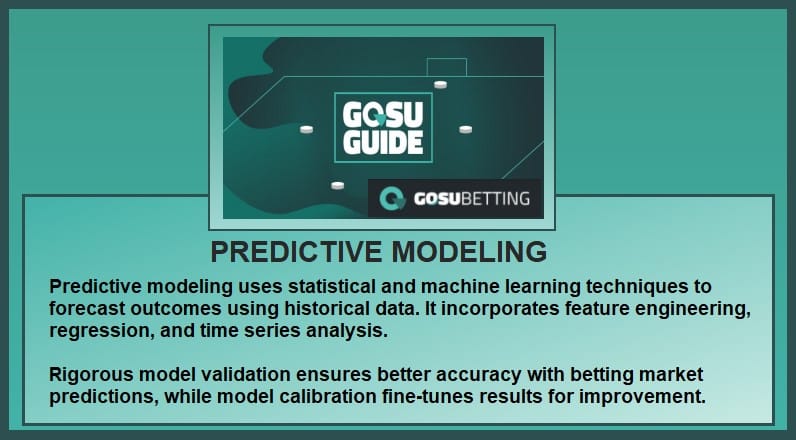In sports betting, relying solely on intuition is often a losing strategy. Predictive modeling offers a data-driven approach to forecasting sports outcomes, using techniques that go far beyond human reasoning. It allows bettors to use data, statistics and algorithms to generate predictions that may provide them with an edge over the market.
What is Predictive Modeling?

Predictive modeling is the process of using statistical techniques and algorithms to forecast future events or outcomes in sports. These techniques aim to understand the drivers of past performance in order to make better predictions about future games, using data-driven forecasting. It allows for a move from subjective assessment to algorithmic prediction, using predictive analytics frameworks.
This form of predictive analysis allows bettors to create models that may be used to assess the probability of events that may otherwise be too difficult to assess with traditional means. The result for bettors is better betting choices.
Core Components: Statistical Modeling and Historical Data
Predictive modeling relies heavily on statistical modeling, which employs mathematical models and statistical methods to analyze data.
These often use techniques from quantitative methods. This relies on historical data, often made up of historical outcomes, relevant data points, and time series data, which forms the input for model creation.
The data is analyzed using techniques from data analysis.
Statistical modeling combined with a thorough analysis of historical data provides the base for building effective forecasting models. This approach also provides statistical inference.
The Power of Machine Learning
Machine learning, a type of artificial intelligence, allows models to learn from data and improve over time. They achieve this by training models based on algorithmic learning, thus allowing for pattern recognition.
Techniques such as supervised learning, unsupervised learning, reinforcement learning and deep learning may all be applied.
Machine learning can uncover complex patterns in data that humans might miss, leading to more accurate and dynamic predictions. The techniques can also help with model optimization.
Feature Engineering: Refining the Inputs
Before models can be built, raw data needs to be refined. Feature engineering is the process of selecting, transforming, and creating variables from this data to improve model performance. This may include variable transformation, feature creation and variable selection.
Carefully designed features can provide the models with the most relevant signals from the data and will improve overall model performance. This improvement can also be used to reduce data dimensionality.
Model Validation and Iteration
Once built, it is essential to validate models and assess prediction accuracy. Model validation is the process of assessing the model’s performance on unseen or out-of-sample data to ensure its accuracy and reliability. This can involve in sample testing, out of sample testing, and performing robustness testing.
Model calibration allows us to adjust parameter estimation in order to allow better data fitting.
This validation step helps identify models that are robust and provides confidence in their predictions. It may involve iterative improvement, and parameter optimization to improve overall results.
Regression Analysis and Time Series Analysis
Regression analysis is a core statistical method used within predictive modeling. These regression models allow us to understand the relationship between one variable and other predictor variables.
Time series analysis allows us to identify seasonality, using techniques such as trend detection to understand time-dependent data, using forecasting models. This also involves studying any forms of autocorrelation in the data.
These methods provide crucial insights into the relationships and trends in the data while helping in model building, model fitting, and delivering an assessment of feature importance.
Data Analysis as a Core Skill
Data analysis forms the core skill required to successfully create and implement predictive modeling. It will require techniques such as data cleaning data exploration, a solid understanding of descriptive statistics, using statistical summaries and overall exploratory data analysis.
These are the core skills that allow for overall information discovery and insight extraction. Data Analysis helps in making sense of data, preparing it for use in models, and understanding the results.
By utilizing predictive modeling techniques, sports bettors can gain a competitive edge by making data-informed decisions, assessing the probabilities of various outcomes, and moving beyond purely speculative betting strategies, allowing for more robust decision-making and improved understanding of the underlying forces that drive sports events.
Key Takeaways
- Data-Driven Predictions: Predictive Modeling moves away from subjective assessments to data driven forecasts.
- Uncovering Patterns: Machine learning can identify patterns that humans often miss.
- Improved Accuracy: Models that are properly validated will be more accurate than human forecasts.
- Competitive Edge: All of the techniques offer a more structured and informed way of betting.
- Continuous Improvement: The combination of iterative model development with testing helps bettors to continuously improve their strategies.
By understanding and using predictive modeling techniques, sports bettors can enhance their ability to forecast sports outcomes and greatly improve their overall betting strategies.
Ready to test your predictive modeling skills? Try some tests at any of these GOSUBetting recommended crypto bookmakers.
Top Bitcoin Betting Sites
BC.Game
Welcome Bonus: Four-part deal up to $1,600
18+ – Gamble responsibly – GambleAware.org – T&C’s apply




